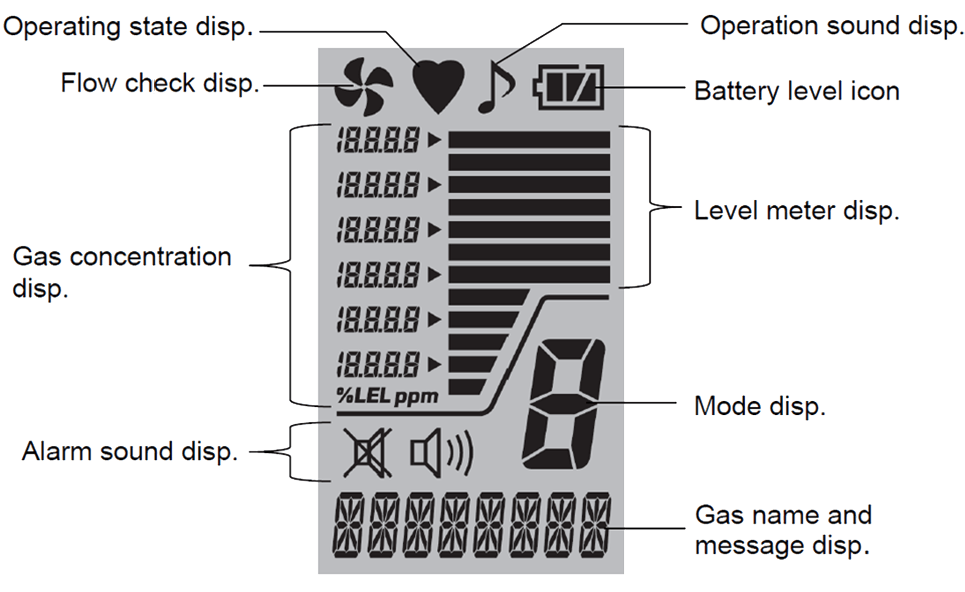The Riken Keiki SP-220 Series are state of the art Gas Leak Detectors
The SP-220 has a rugged, light weight design as well as a fast response time. Ease of operation will make pinpointing hard-to-find, low concentration gas leaks a simple procedure.

Flexibility for any application.
Download on to computer with optional IrDA adapter & read with free software.
Detect hard to find leaks quickly
Rugged for harsh environments.
Easy to handle and grip for confined area leak detection.
Good for leak detection in dark hard to reach spaces.
Ideal for leak detection is hard to reach dark spaces.
The lightweight SP-220-SC is a highly sensitive Gas Leak Detector for Toxic, Combustible and CFC Freon gases.
The SP-220 Type SC version uses a hot-wire semiconductor sensor (MOS) that can detect a range of target gases.
Select from any of the forty listed gases for a direct reading referenced from a single calibration gas (PH3).
This new model SP-220-SC replaces the SP-205ASC used by the semiconductor industry for high sensitivity leak checking of hydride gases.
The SP-220 Type M / L and ML are highly sensitive Gas Leak Detectors for Natural Gas as well as LPG
The SP-220 Type F is a version exclusively for CFC Gases.
The SP-220 Type H2 is a version for Hydrogen
The SP-220 Type FUM is a version for Fumigation gases and can detect 7 Fumigation Gases including Phosphine as well as Sulfuryl Fluoride.
The SP-220 Series has an integral pump, LCD display with backlight, moulded rubber cover as well as an LED light and weather protection.
The Instruments have an IP-55 rating for dust and water ingress as well as Snap logging (128 readings) and data-logging (256 data points). These features allow for accurate record keeping in addition to testing accountability.
The SP-220 also has the ability to zero out background gas to help identify if you are getting closer to a leak source.
| No. | Gas name | Display | Concentration | ||
|---|---|---|---|---|---|
| Display 1 (ppm) |
Display 2 (ppm) |
||||
| 1 | Phosphine | PH3 | 0.1 | 2 | |
| 2 | Acetone | C3H6O | 1 | 10 | |
| 3 | Arsine | AsH3 | 0.2 | ✔ | |
| 4 | Ammonia | NH3 | 10 | ✔ | |
| 5 | Isobutane | i-C4H10 | 1 | 10 | |
| 6 | Isopropyl alcohol | IPA | 1 | 10 | |
| 7 | Carbon monoxide | CO | 10 | 30 | |
| 8 | Ethyl alcohol | C2H5OH | 1 | 10 | |
| 9 | Ethylene | C2H4 | 1 | 10 | |
| 10 | Vinyl chloride | VCM | 1 | ✔ | |
| 11 | Methyl chloride | CH3CL | 1 | 10 | |
| 12 | Xylene | C8H10 | 1 | 10 | |
| 13 | Ethylene oxide | EO | 1 | 10 | |
| 14 | Silane | SiH4 | 0.5 | ✔ | |
| 15 | Methyl bromide | CH3Br | 1 | 20 | |
| 16 | Hydrogen | H2 | 1 | 10 | |
| 17 | Trichloroethylene | C2HCL3 | 10 | ✔ | |
| 18 | Toluene | C7H8 | 1 | 10 | |
| 19 | 1,2-Dichloroethane | EDC | 1 | 10 | |
| 20 | Sulfur dioxide | SO2 | 1 | ✔ | |
| 21 | Propane | C3H8 | 5 | 20 | |
| 22 | R-134a | R-134a | 50 | 250 | |
| 23 | R-22 | R-22 | 10 | 50 | |
| 24 | R-32 | R-32 | 10 | 50 | |
| 25 | n-hexane | n-C6H14 | 10 | 50 | |
| 26 | Benzene | C6H6 | 0.5 | 10 | |
| 27 | Formaldehyde | HCHO | 10 | 50 | |
| 28 | Methane | CH4 | 1 | 20 | |
| 29 | Methyl alcohol | CH3OH | 1 | 10 | |
| 30 | Methyl ethyl ketone | MEK | 1 | 10 | |
| 31 | Hydrogen sulfide | H2S | 0.1 | ✔ | |
| 32 | Diborane | B2H6 | 0.1 | ✔ | |
| 33 | Germane | GeH4 | 0.2 | ✔ | |
| 34 | Hydrogen bromide | HBr | 10 | ✔ | |
| 35 | Hydrogen chloride | HCL | 10 | ✔ | |
| 36 | R-407C | R-407C | 10 | 50 | |
| 37 | Hydrogen selenide | H2Se | 0.5 | ✔ | |
| 38 | R-410A | R-410A | 10 | 50 | |
| 39 | R-404A | R-404A | 10 | 50 | |
| 40 | 2,3,3,3-Tetrafluoropropene | CH2C2F4 | 10 | 30 | |
| Note 1) ✔ means there is sensitivity, but no value can be given. Note 2) Alarm accuracy, response time etc. are confirmed with calibration gas (PH3) Note 3) The measuring results of the gas selection are intended for guidance only. The most accurate measurement is for calibration gas (PH3). |
|||||
We are able to provide products and advice usually within short timescales. For product advice, servicing and enquiries, please contact our experienced team: